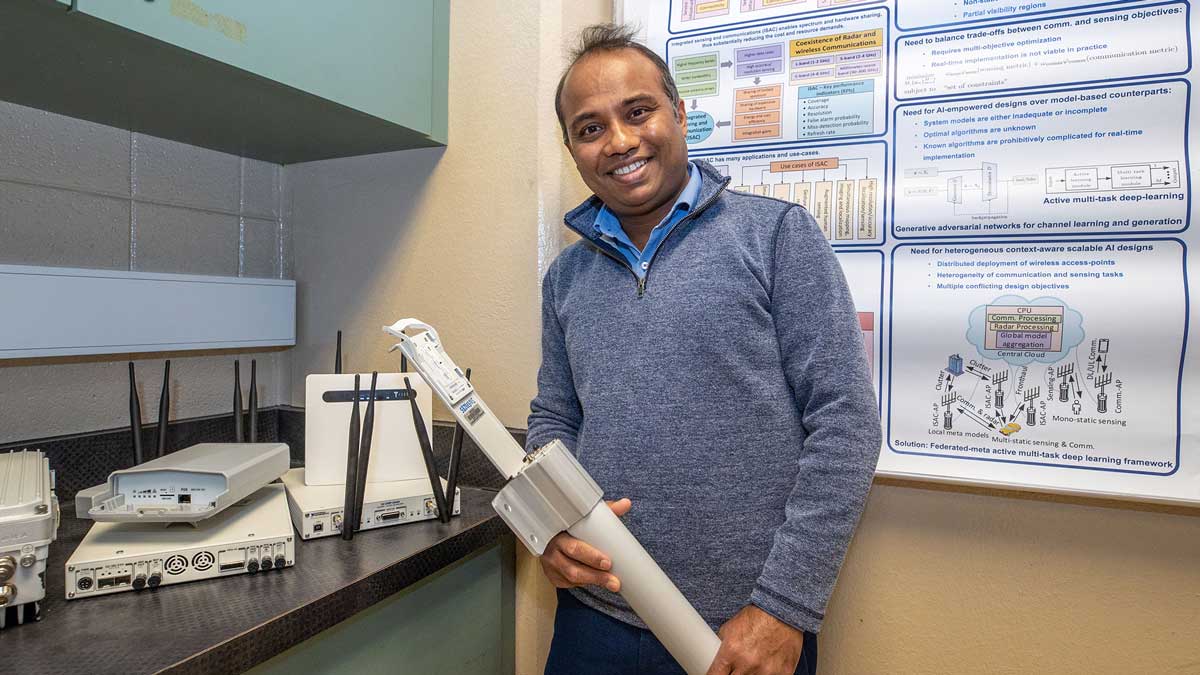
Gayan Aruma Baduge, associate professor in the School of Electrical, Computer and Biomedical Engineering, is leading an international team of researchers working with a total of $1.13 million in grant money. The three-year project is aimed at investigating AI-assisted integrated sensing and communications for 6G technology. (Photo by Russell Bailey)
June 03, 2024
SIU researcher leads $1.13M project to integrate AI into 6G technology
CARBONDALE, Ill. – Imagine a world in which a highly intelligent wireless system can monitor the environment and fight pollution, send a fleet of cars to transport several people and help find a missing young child because it can identify anyone anywhere. Sixth generation wireless – or 6G – is on the horizon, and a Southern Illinois University Carbondale researcher is working on the integral aspects that will make it function.
Gayan Aruma Baduge, associate professor in the School of Electrical, Computer and Biomedical Engineering, is leading an international team of researchers working with a total of $1.13 million in grant money. The teams include SIU and Villanova University in the United States and Aalto University of Finland.
SIU’s portion of the grant, which comes from the National Science Foundation, totals $336,500. The three-year project is aimed at investigating AI-assisted integrated sensing and communications for 6G technology.
“This is a unique research partnership that bridges the European Union and United States, with a focus on advancing the fields of artificial intelligence and integrated sensing and communications,” Baduge said.
In addition to voice and data communication services like those used today, 6G technology is also expected to include sensing functions, such as highly accurate location tracking and mapping, area imaging, and operation of autonomous vehicles, including “platooning,” which involves operating several vehicles together as one unit.
Powered and controlled by advancing artificial intelligence, the technology also will be able to perform new functions related to surveillance, including detecting what kind of gestures or activities humans may exhibit, as well as identifying the people making them. Such abilities in the system are aimed at extracting, classifying and predicting typical movements of the human body such as standing, sitting, walking, jumping, smiling or crying, for example.
Baduge’s work centers on developing the theoretical foundations of the technology, designing wireless systems that can integrate mobile communications and environment imaging and sensing in future wireless systems. Combining the system would increase efficiency and functionality.
“The 6G wireless systems with integrated sensing and communication functionalities can be useful for environmental monitoring, vehicular networks, remote sensing,” Baduge said. “It would also facilitate the creation of smart cities while improving industry, manufacturing and agriculture.”
A key to making 6G everything it promises to be involves leveraging the similarities between existing radio sensing and communication systems. Such systems already share – or are beginning to share – frequency spectrums, hardware architecture and information processing pipelines.
Baduge hopes to design a structure that more formally combines the two systems into a single hardware platform using a unified waveform and transmission strategy controlled by AI. Such a system would be much more capable of processing signals from various sensors while also handling common cellphone and data transmission.
Evolution of the systems
Historically, wireless radio systems for cellular communications and radar sensing were designed and operated independently. The systems used different waveforms, non-overlapping radio frequency bands, and separate hardware platforms.
The current state-of-the-art 5G wireless communication systems have been designed and optimized primarily for mobile cellular communications. The demand for higher data rates and the number of connected wireless devices, however, is increasing, and satisfying this demand has prompted engineers to use large antenna arrays operating at higher frequencies where radar also lives.
In short, it’s getting crowded.
“The electromagnetic spectrum or radio frequency band used for communication and sensing purposes is an extremely scarce and expensive resource,” Baduge said. “Integrating communication and sensing tasks into the same hardware platform can greatly improve efficiency.”
Such a design can also be cost effective as expensive radio frequency equipment can be reused for communication and sensing purposes, he said.
Challenges ahead
Integrating two systems designed for different things is extremely challenging, Baduge said, as data communication and radar sensing tasks have mutually competing design objectives.
“Because of that, we’re proposing to use a range of tools from communications and information theory, estimation and detection, and data-driven artificial intelligence to overcome the design challenges,” he said.
Baduge hopes the research will help integrate radio sensing functionality into 6G technology, including cellular communication systems, wireless local area networks and industrial internet-of-things networks (“smart” homes and appliances, etc.), while keeping costs low and conserving frequency spectrum and computational capacity.
